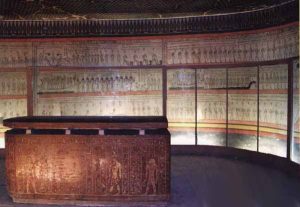
Some scholars named Tuthmosis III "Napoleon of the East", but we think that Napoleon is the one who have to be named by the name of Tuthmosis, (Tuthmosis means born by Thoth). In the first twenty-two years of Tuthmosis III's reign, he was co-regent with his stepmother, Hatshepsut. After her death, he ascended the throne and became the pharaoh of the kingdom. He created the largest Egyptian empire that had ever been seen. Officially, Tuthmosis III ruled Egypt for almost fifty-four years, including the 20 years of Queen Hatshepsut. King Tuthmosis III was one of the first pharaohs to be buried in the Valley of the Kings, and his tomb is the oldest decorated tomb in the valley. KV 34 was discovered in 1898 and cleared by Victor Loret, the director of the Antiquities Service. The tomb is in an unusual location as it lies in a narrow cut in the bedrock cliffs, high above the floor of the Valley of the Kings. The tomb is reached through a steel staircase rising over twenty meters above the Valley floor. The mummy of the pharaoh was found in the cachette at Deir Al-Bahari in 1881.- Architecture of the Tomb of Thutmosis III
Tomb KV 34 has the classic plan used in the tombs of the Eighteenth Dynasty, with a sharp turn at the vestibule preceding the burial chamber. There are two corridors leading to a vestibule with two columns preceded by a quadrangular shaft with an astronomical ceiling.
- The Vestibule of the Tomb of Thutmosis III
The Vestibule of Tomb KV 34 is decorated with very unique and distinctive scenes compared to any other scenes in any tomb in the Valley. The scenes show the 741 deities in the Book of Imydwat. On the two pillars in the middle of the chamber, there are texts from the Litanies of Re, a text that celebrates the sun-god as well as the pharaoh, who is identified with him and with other gods. The east pillar houses one of the very unique and impressive scenes in the tombs of the Valley of the Kings. The scene shows Tuthmosis III as a boy being suckled by the goddess Isis in the guise of a tree. Preceding him is the King as an adult with his wife.
- The Well Chamber of the Tomb of Thutmosis III
The roof of the Well Chamber of the Tomb of Thutmosis III is decorated with yellow stars on a blue background and a Khekher-frieze along the top of the walls. Ahead of the well shaft, there is Chamber F which is a squared room with two undecorated pillars. The walls of the chamber are finely painted with the names of the 741 deities of the Imydwat. In the left front corner of the room, there is a staircase that leads to the Burial Chamber.
- The Burial Chamber of the Tomb of Thutmosis III

The Burial Chamber of Tomb KV 34 has an oval shape and its ceiling is supported by two pillars. Most probably the shape was intended to represent a royal cartouche. The chamber is about 14.6 meters by 8.5 meters and its walls are decorated with scenes and texts from the Imydwat. This chamber houses the unique yellow quartzite sarcophagus of Tuthmosis III. Having a cartouche shape, it still sits in the middle of the Burial Chamber. It was painted red to imitate red granite and its sides are decorated with figures of the King and various deities. The mummy of King Tuthmosis III was taken from the tomb and reburied in TT 320, the cachette of royal mummies near Deir al Bahari.
- The Imydwat Book in the Tomb of Thutmosis III
The Book of Imydwat consists of twelve hours. The scenes of those hours are depicted upon the walls of the Burial Chamber of KV 34. The first, second, third, and fourth hours are found on the front wall; the fifth and sixth on the right wall, seventh and eighth on the left, and the ninth to twelfth on the rear wall. The first hour starts at the entrance to the Netherworld. It shows the Netherworld's inhabitants and continues the list of 741 deities given in Chamber F. In the second and third hours, the Netherworld's fertile farmlands are described and evil beings are overcome by knife wielding figures. The fourth hour takes us to the desert land of Ro-setau, the Land of god Sokar who is Upon His Sand, a place of snakes, barred doors and darkness. In the fifth hour, male and female figures tow the solar barque through blackness and thirst. In the sixth hour, the sun is in the form of a scarab beetle and reaches midnight in the depths of the Netherworld. Gods Ra and Osiris join together and the dead living king brings his ancestors back. The seventh hour: Apophis, the snake-god, blot out the sun, but he is defeated by Isis, Seth, and Osiris, and they triumph over him. In the eighth and ninth hours, the sun-god Ra opens the doors of five caverns for the worthy dead. In the tenth hour, there is a rectangular pool filled with the floating bodies of those who have drowned. They are considered especially blessed and, although a normal funeral is not possible, Horus carries them safely into the Netherworld. In the eleventh hour, there are twelve men and women pull the divine solar barque of the blessed dead into day light, and the sun, shown as a beetle, joins Shu, the god of air, at the start of another day.
